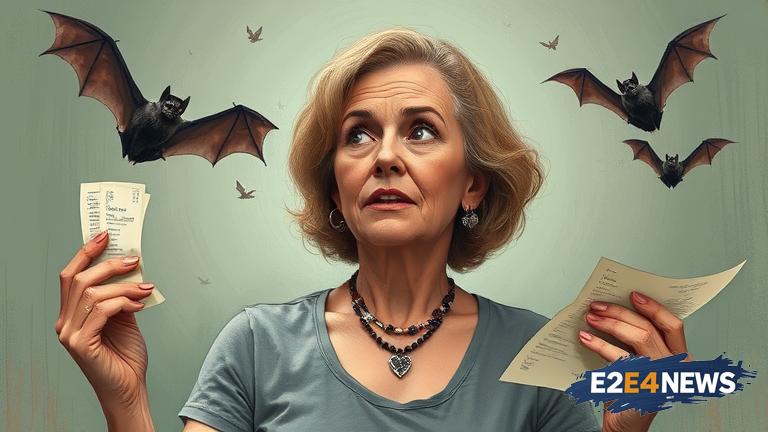A recent incident in the United States has brought attention to the unexpected dangers of wildlife encounters. A woman, whose identity has not been disclosed, experienced a shocking and unsettling event when a bat flew into her mouth. The incident, which may seem like a rare and isolated occurrence, has resulted in significant medical expenses for the woman. According to reports, the woman has accumulated nearly $20,000 in medical bills as a result of the bat’s unwelcome visit. The bat, which was likely disoriented or lost, somehow managed to fly into the woman’s mouth, causing her to seek immediate medical attention. The woman’s ordeal began when she felt the bat’s presence in her mouth, which understandably caused her a great deal of distress and discomfort. She promptly visited a nearby medical facility to receive treatment and undergo a series of tests to determine the extent of any potential health risks. The medical professionals attending to the woman took necessary precautions to ensure her safety and well-being, including administering post-exposure prophylaxis (PEP) treatment to prevent the potential transmission of rabies. The PEP treatment, which consists of a series of injections, is a standard procedure in cases where individuals have been exposed to potentially rabid animals. In addition to the PEP treatment, the woman also underwent a thorough examination to check for any other potential health risks associated with the bat’s bite. The medical expenses incurred by the woman are a testament to the significant costs associated with treating and preventing diseases transmitted by wildlife. The incident serves as a reminder of the importance of being aware of one’s surroundings and taking necessary precautions when interacting with or approaching wildlife. Bats, in particular, are known to carry diseases such as rabies, which can be transmitted to humans through bites or scratches. The risk of disease transmission is a serious concern, and individuals who have been exposed to potentially rabid animals must seek medical attention promptly to minimize the risk of infection. The woman’s experience highlights the need for increased awareness and education about the potential risks associated with wildlife interactions. Furthermore, the incident underscores the importance of having access to adequate medical care and resources to treat and prevent diseases transmitted by wildlife. The significant medical expenses incurred by the woman are a burden that could have been mitigated with proper precautions and awareness. In conclusion, the incident involving the bat and the woman serves as a reminder of the potential risks and consequences associated with wildlife interactions. It is essential for individuals to be aware of their surroundings, take necessary precautions, and seek medical attention promptly if they have been exposed to potentially rabid animals. By taking these steps, individuals can minimize the risk of disease transmission and avoid the significant medical expenses associated with treating and preventing diseases transmitted by wildlife. The incident has sparked a wider discussion about the importance of wildlife awareness and education, and the need for increased access to medical care and resources. As the woman continues to recover from her ordeal, her experience serves as a cautionary tale about the potential risks and consequences associated with wildlife interactions. The incident has also raised questions about the measures in place to prevent such incidents and the support available to individuals who have been affected by wildlife interactions. In the aftermath of the incident, local authorities and wildlife experts have emphasized the importance of being aware of one’s surroundings and taking necessary precautions when interacting with or approaching wildlife. The woman’s experience has also highlighted the need for increased awareness and education about the potential risks associated with wildlife interactions, particularly in areas where wildlife is common. By promoting awareness and education, individuals can take necessary precautions to minimize the risk of disease transmission and avoid the significant medical expenses associated with treating and preventing diseases transmitted by wildlife.


